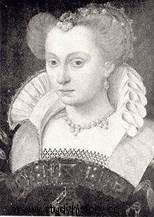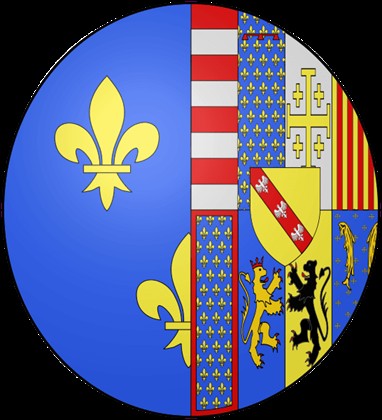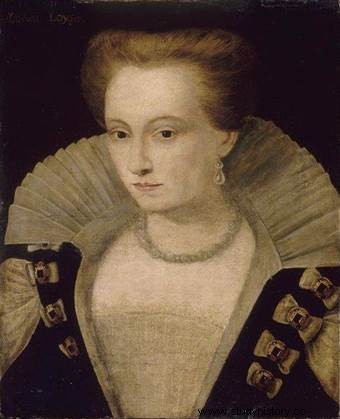 Louise of Lorraine-Vaudémont is the last queen of France from 1575 to 1589, in the time of the Valois, without posterity. Her marriage to Henry III was the only one not carried out for politics, but inspired by a "true and sincere inclination". Sweet, beautiful, unpretentious, without fortune, an ally of Catherine de Medici, she was an ideal queen with the behavior of a sovereign. She is the only queen to actually rest in the tomb that bears her name in Saint Denis!
Louise of Lorraine-Vaudémont is the last queen of France from 1575 to 1589, in the time of the Valois, without posterity. Her marriage to Henry III was the only one not carried out for politics, but inspired by a "true and sincere inclination". Sweet, beautiful, unpretentious, without fortune, an ally of Catherine de Medici, she was an ideal queen with the behavior of a sovereign. She is the only queen to actually rest in the tomb that bears her name in Saint Denis!
Louise of Lorraine, a wife for Henry III
At the death of Marie de Cleves, Henry's youthful love, the young king is prostrate, has a macabre behavior (his clothes bear emblems of skulls) , is stricken with mystical crises and follows processions of penitents. Catherine de Medici must marry him urgently and offers him several suitors:Dona Juana the sister of Philip II, Marie Stuart widow of François II, her sister-in-law Elisabeth widow of Charles IX, the Queen of England from whom Henri has a sacred opinion "he's an old creature, with a sick leg". To cut short the other proposals (a Swedish princess or a Danish), the king declares that his choice is made:it will be Louise de Vaudémont!
A discreet lady
Born in April 1553, to Nicolas de Mercœur, Count of Vaudémont, belonging to the younger branch of the House of Lorraine, Louise, cousin of the Guises, was the eldest of fourteen children , and was only one year old when his mother Marguerite d'Egmont died. The second wife of Nicolas de Mercœur:Jeanne de Savoie-Nemours is affectionate and introduces him to the court of Nancy, Louise is ten years old. Catherine d'Aumale, her father's third wife, is rude and jealous, but Louise can count on the friendship of Claude, second daughter of Catherine de Medici and Henri II.
Tall, blonde, of a delicate, discreet beauty, Henri met her in Lorraine when he was leaving for Krakow. She knew how to move him with her modesty and gentleness. She may be a young girl without rank, without fortune, without pretensions, but "he wanted to take a wife of his nation who was beautiful and pleasant, saying that he wanted one to love her well and have children, without going to look for others far away, as his predecessors had done”. Catherine de Medici loves her son so much that she approves! She was won over by "the gentle and devout spirit of this princess, whom she considered more proper and devoted to praying to God than to meddling in business".
As for Louise, she renounces two suitors (François de Luxembourg and the Comte de Salm) and the king offers one of the two his current mistress the young lady of Châteauneuf!
A non-political marriage…
Louise's father gave his consent very quickly, and within a month, "everything was done":the king arrived in Reims on February 11, was crowned on the 13th, and the wedding takes place on February 15, 1575! Louise is radiant with joy, the king's heart melts with tenderness. They return to the capital, she is Queen of France!
 From that day on, Louise never changed her attitude and remained dazzled and amazed. Her love for her husband will withstand time, trials, infidelities and death! Occupying little space, it blends into the king's entourage, always with him, in all the ceremonies, all the festivals, all the feasts. She is associated with the creation of the Order of the Holy Spirit (the insignia bear their initials). It is etiquette that the king pays him a daily visit, he does more:they go for a walk in Paris, visit monasteries, discover the sea in Normandy, the port of Dieppe, stay on the land of Ollainville (castle that the king offers it to him and which he makes redevelop). All these attentions last well beyond the honeymoon:in 1581, she is seen installed on the knees of the king; in 1587, he “spent almost the whole day with her and tries by words full of affection to exhort her to keep courage” when she is seized with a tertian fever; like Francis I, the king does not officially introduce a royal mistress, because Louise means a lot to him.
From that day on, Louise never changed her attitude and remained dazzled and amazed. Her love for her husband will withstand time, trials, infidelities and death! Occupying little space, it blends into the king's entourage, always with him, in all the ceremonies, all the festivals, all the feasts. She is associated with the creation of the Order of the Holy Spirit (the insignia bear their initials). It is etiquette that the king pays him a daily visit, he does more:they go for a walk in Paris, visit monasteries, discover the sea in Normandy, the port of Dieppe, stay on the land of Ollainville (castle that the king offers it to him and which he makes redevelop). All these attentions last well beyond the honeymoon:in 1581, she is seen installed on the knees of the king; in 1587, he “spent almost the whole day with her and tries by words full of affection to exhort her to keep courage” when she is seized with a tertian fever; like Francis I, the king does not officially introduce a royal mistress, because Louise means a lot to him.
All is not rosy, however. The king has a mistress, a lady advises Louise to take a lover:she is driven out! A conspiracy is led by one of the king's minions who breaks into the queen's room, the minion becomes Henri's pet peeve, the affair turns into a state affair! But this strengthens the ties between the king and the queen, because Louise has the qualities of a queen of the time:piety, discretion, obedience, love of the monarch...
Brantôme said “We can and we must praise this princess a lot; for, in her marriage, she behaved with the king her husband so wisely, chastely and loyally, that the knot in which she was tied in conjunction with him remained always so firm and indissoluble, that it was never found deffait ny untied, although the king loved her husband and allast well sometimes at the exchange”; “She devoted herself to nothing but serving God, going to devotions, continually visiting hospitals, dressing the sick, burying the dead”.
… but no children
She takes part in a procession in a penitent's costume, hoping for a child! Because from the beginning of their union, she wishes to offer a dolphin to the king. Unfortunately, the couple is and remains sterile, many think of the king's sterility (because of his inclinations). They had themselves examined, called on potion "makers", went for thermal cures, the king launched into prayers and gestures of devotion, he made pilgrimages from 1580 to 1586, she did not adhere to the sessions mystics of her husband, she tries to understand him, to help him, but does not approve of him. The couple remains united and united, but they are resigned, they will not have children:God wills it that way.
Valuable support
 An irreproachable Catholic, she devoted herself to the poor, orphans and prisoners. She sponsors a Maison de Charité in the Mouffetard district. We also owe him the light at crossroads, thanks to statues of Madonna lit by a lamp. Her popularity increased when she allocated a pension to two students in 1586 so that "they would preach on Sundays and annual feasts in the prisons of the Conciergerie, the Grand and Petit Chastelet de Paris".
An irreproachable Catholic, she devoted herself to the poor, orphans and prisoners. She sponsors a Maison de Charité in the Mouffetard district. We also owe him the light at crossroads, thanks to statues of Madonna lit by a lamp. Her popularity increased when she allocated a pension to two students in 1586 so that "they would preach on Sundays and annual feasts in the prisons of the Conciergerie, the Grand and Petit Chastelet de Paris".
During the troubles of the League, she supports her husband, against his family of Lorraine:it is an act of honor. She even goes so far as to reproach him for rebelling! When the king decides to arrest the Duke of Guise, she approves; during the days of the barricades, cloistered in Paris, she faces the Duke of Guise alone; she supports her husband when he decides on the death of his enemy; she is still at his side for the interview at Plessis les Tours.
But on August 4, 1589, she received a final letter:the king had just been the victim of an attack, and wanted to reassure her "My friend, I hope that I will be very well; pray to God for me and don't budge from here”.
She mourns but does not forgive!
Louise mourns in white, settles in Chenonceau in a room facing the river and organizes her life:walks, embroidery, reading the Lives of the Saints, Sunday service in the small church of Francueil. In her room, there are souvenirs of her husband everywhere:a portrait on the fireplace with the motto "saevi monumenta doloris", burning torches, widow's cords, all against a black velvet background.
She does not forgive those who killed her husband and "desires no more life except to see the punishment meted out to those who make her so miserable". Half satisfied only when the prior of the convent to which Jacques Clément belonged was condemned to death, and because the Guises were responsible, she appealed to Henri IV:he evaded the question and absolved the Duke of Mayenne and the Lorraine princesses in 1596!
She will never forgive! She begged the pope for the Church to make amends for all that had been done against the king and many years later, the pope finally canceled the excommunication and proclaimed Henry III dead in peace with the Church.
Louise of Lorraine in Saint Denis
But Louise is tired and worn out from this fight. She receives a final blow:she has to leave Chenonceau! Catherine de Medici's will presenting more liabilities than assets, Louise would have to pay her share of her mother-in-law's debts if she wants to keep the castle, which is impossible!
The estate was auctioned off in December 1593; the half brother of Louise a Mercœur, buys Chenonceau, leaves it to Louise, but the responsibility to donate it to the young future spouses:Mercœur's only daughter and little César (who has just been born) son of Henri IV and by Gabrielle d'Estrées. She has the usufruct, but prefers to leave these places of sorrow and settles in the duchy of Bourbonnais, in Moulins. She died at the end of January 1601, after catching cold in a church during a sermon the previous December.
She is the only queen to actually rest in the tomb that bears her name in Saint Denis:she was first installed in the Capucines convent in the Faubourg Saint Honoré, then in the new Capucines church near Place Vendôme, was transported to Père Lachaise during the Revolution and reached Saint Denis in 1817. While all the tombs of the kings had been violated and the remains thrown into the common grave!
Sources
- Simone Bertière – The bloody years – the queens of France in the time of the Valois.
